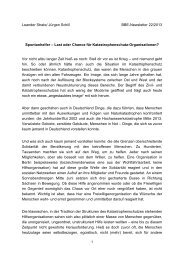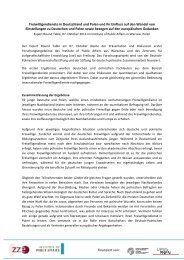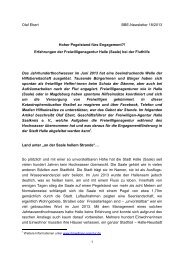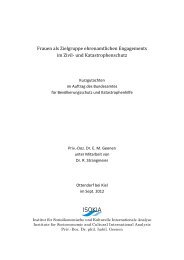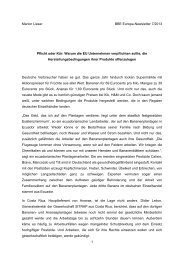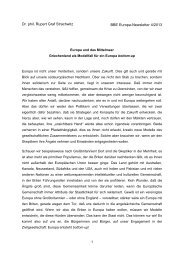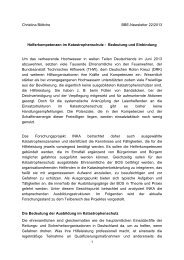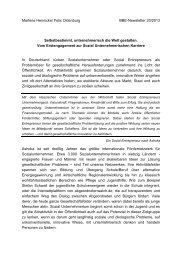ENGAGEMENT UND ERWERBSARBEIT IN EUROPA - BBE
ENGAGEMENT UND ERWERBSARBEIT IN EUROPA - BBE
ENGAGEMENT UND ERWERBSARBEIT IN EUROPA - BBE
Sie wollen auch ein ePaper? Erhöhen Sie die Reichweite Ihrer Titel.
YUMPU macht aus Druck-PDFs automatisch weboptimierte ePaper, die Google liebt.
evers: changes in work and human services and their impact on volunteering<br />
with its convictions and models. We find a diversity<br />
of lifestyles and cultural subgroups that mostly give<br />
little or no guidance whether or not one should volunteer<br />
or enter into civic engagement. The message<br />
is: it´s up to you.<br />
This correspond to the often observed fact that firm<br />
social ties and obligations have corroded and given<br />
way to forms of volunteering and civic engagement<br />
that may not be less challenging or widespread, but<br />
where the respective persons engaged make a reservation<br />
as to the time and liability of their engagement;<br />
likewise the simple question “what do I get<br />
from this?” gets more important.<br />
All these epochal processes and developments<br />
brought along a central modern concept of volunteering<br />
which nowadays gets dissolved to some degree.<br />
This idea of a change that is concerning society<br />
as a whole and which can not be attributed to one<br />
single sector of it should be kept in mind. Because<br />
the present changes in work and human services<br />
and their impact on the inherited paradigm of volunteering<br />
that I will discuss in the following should be<br />
seen as a part of it. They are both causes and effects<br />
for more global changes and what they entail for historical<br />
concepts of volunteering.<br />
3. twO basic trends: the waning bOundaries<br />
Of labOur and the eVer grOwing iMpact Of<br />
prOfessiOnalized huMan serVices – what<br />
can be their iMpact On VOlunteering?<br />
When taking up the first one of these two trends –<br />
changes in paid work and labour markets –, two kind<br />
of development seem for me to be central.<br />
The first profound change is quite often described by<br />
the term of the waning boundaries of labour. What<br />
is meant by that? It is concerning the weakening of<br />
a traditional model of placing paid work in our life<br />
and of limiting the room given to paid work in our<br />
everyday lives. This is concerning the way it is placed<br />
over the life cycle, the possibility to give it a clear<br />
beginning and end within a working day or by setting<br />
limits to the orientations and values associated with<br />
the world of labour so that they do not intrude into<br />
community life. The first kind of dissolution of old<br />
boundaries of labour have to do with the fact that<br />
across the lifecycle the clear sequence and separation<br />
of being in the phase of education and training,<br />
being engaged in paid work and being on retirement<br />
30<br />
are waning. The same holds true for the placement<br />
of working times in everyday life with unorthodox<br />
working times across the seven days/twentyfour<br />
hours week getting more impact.<br />
Less clear and effective boundaries between working<br />
life and other dimensions of life may result as<br />
well from the fact that on the one hand evermore<br />
people are in contact with working life yet this<br />
contact is taking to a lesser degree the form of a<br />
regulated standard full post. Forms of contact with<br />
the world of labour are increasing, that reach from<br />
casual and part time work over to short term employment.<br />
By all this the forms of linking living and<br />
working get more diverse and this holds arguably<br />
true as well for types of placing volunteering within<br />
work life concepts. Former covering-all models of<br />
work are giving room to all sorts of group-specific<br />
and individual models.<br />
The second big and sweeping change I want to discuss<br />
here has to do with the dynamic expansion of<br />
human services and their role in everyday-life. It is<br />
experienced in areas such as professional child care<br />
and in help and care for the increasing number of<br />
frail elderly people but it is felt as well in the areas<br />
of cultural and recreational services. By the metaphor<br />
of “bowling alone” one aspect of this change<br />
in the world of human services has got widespread<br />
attention.<br />
On the long way to the personal social services of today<br />
there has always be an interaction of voluntary<br />
based initiatives and statebased professional institutions.<br />
Mostly the former took the lead, pioneering<br />
the early hospitals, kindergardens and homes for<br />
the elderly. Stepwise these became – on a “ladder of<br />
extension” as the English intellectuals and social reformers<br />
of the early 20th century, the Webbs, once<br />
called it - mainstreamed, i.e. supported or taken<br />
over by state institutions and professionalized. However<br />
often voluntary contributions stayed part of<br />
the new public services as it can be observed when<br />
looking at school boards or support associations for<br />
public services such as theatres or libraries. Besides<br />
volunteering inside professional human services one<br />
can find it as well outside the established institutions<br />
of service providers taking the form of associations<br />
that offer complementary forms of care on a<br />
voluntary basis or such offers in sports and leisure.<br />
The increase of human and more specifically many<br />
social, health and educational services has chan-



